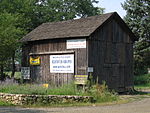Norfield Historic District
Buildings and structures in Weston, ConnecticutColonial Revival architecture in ConnecticutConnecticut Registered Historic Place stubsFederal architecture in ConnecticutGreek Revival architecture in Connecticut ... and 6 more
Historic districts in Fairfield County, ConnecticutHistoric districts on the National Register of Historic Places in ConnecticutNRHP infobox with nocatNational Register of Historic Places in Fairfield County, ConnecticutUse mdy dates from August 2023Weston, Connecticut

The Norfield Historic District is a 18-acre (7.3 ha) historic district in Weston, Connecticut, United States, that was listed on the National Register of Historic Places in 1991. It includes the present-day town center of Weston, which was known as "Norfield" from 1795 to 1920.It was listed for its meeting architectural criteria, and included 16 contributing buildings. The district includes a total of 25 institutional and residential buildings, of which nine are more modern and non-contributing including the town hall and town library. The Norfield Congregational Church is the most prominent building.
Excerpt from the Wikipedia article Norfield Historic District (License: CC BY-SA 3.0, Authors, Images).Norfield Historic District
Norfield Road,
Geographical coordinates (GPS) Address Nearby Places Show on map
Geographical coordinates (GPS)
| Latitude | Longitude |
|---|---|
| N 41.201111111111 ° | E -73.378888888889 ° |
Address
Norfield Road 53
06883
Connecticut, United States
Open on Google Maps








